本文目录
英语强调句型结构及用法
陈述句的强调句型。
It is/ was + 被强调部分(通常是主语、宾语或状语)+ that/ who(当强调主语且主语指人)+ 其他部分。
例子 It was yesterday that he met Li Ping。
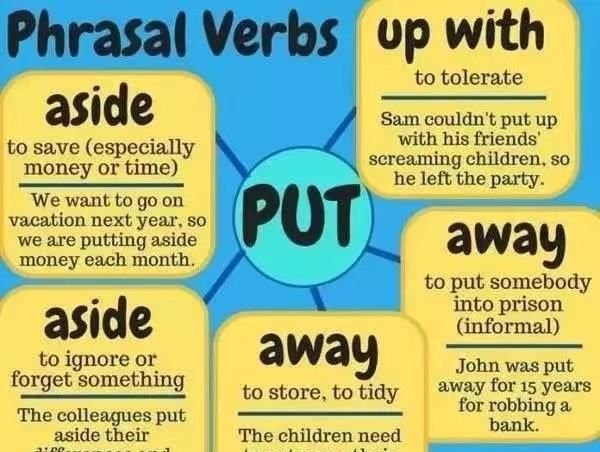
2. 一般疑问句的强调句型。
同上,只是把is/ was提到it前面。
例子 Was it yesterday that he met Li Ping?
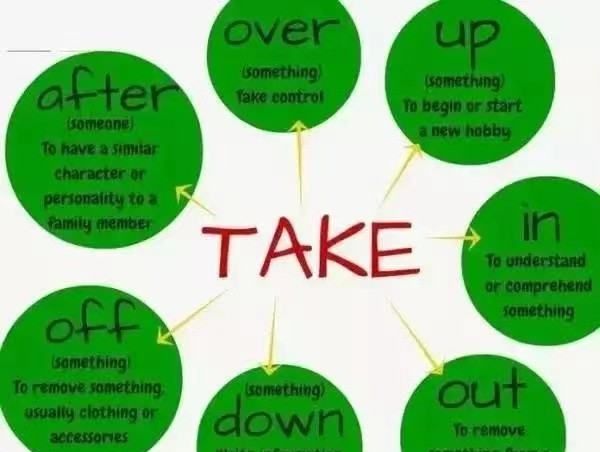
3. 特殊疑问句的强调句型。
被强调部分(通常是疑问代词或疑问副词)+ is/ was + it + that/ who + 其他部分?
例子 When and where was it that you were born?
4.not … until … 句型的强调句。
句型为:It is/ was not until + 被强调部分 + that + 其他部分。
强调句:It was not until his wife came back that he went to bed。
5.谓语动词的强调。
A. It is/ was ... that ... 结构不能强调谓语,如果需要强调谓语时,用助动词do/ does或did。
Do sit down. 务必请坐。
英语强调句型的所有用法
1、强调句的陈述句句型为:It is /was+被强调的部分+that/who引导的从句+原句其他部分。
2、强调句的一般疑问句型:Is / Was +it+被强调的部分+that/ who/ whom引导的从句+原句其他的部分。
3、强调句的特殊疑问句型:特殊疑问词(When /Where/ Why/ Who/ What/ How )+is/ was +it +that从句+原句的其他部分。
4、主谓一致。在强调主语的时候,that后的谓语动词要与被强调者保持是人称和数的一致,例如:It is I who am a teacher。
5、连接词。在强调状语的时候,无论被强调的部分是表示时间还是地点, 能不能用when或者where,连接词只能用that。
无论强调据说强调的主语是单数还是复数,强调句中所用的be动词始终都是is或者是was,如果强调的是将来或者是正在发生的事情或正在进行的动作的时候,只能用is。如果强调过去已经完成的就用was。强调句去掉了it is/ was…+that之后,对于句子的完整性不造成影响。
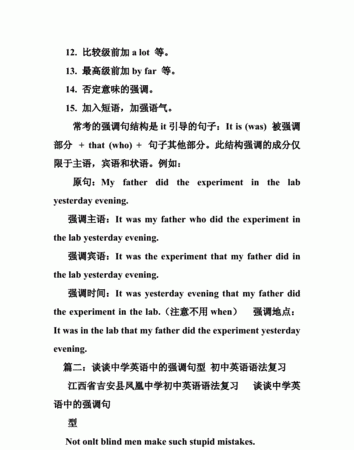
高中英语强调句型的用法
强调句型
[一] it 强调句基本构成形式:It is/ was +被强调部分+ who/ that+原句剩余部分
I met him in the street yesterday afternoon.
It was I who/ that met him in the street yesterday afternoon.
(强调是我,不是别人)
It was him who/ that I met in the street yesterday afternoon.
( 强调我遇见的是他,不是别人)
It was in the street that I met him yesterday afternoon.
( 强调是在大街上,不是在别的地方,强调的是地点,但不用where)
It was yesterday afternoon that I met him in the street .
(强调是昨天下午,不是在别的时候,强调的是时间,但不用when)
强调句的一般疑问句:Is/ Was it +被强调部分+ who/ that+原句剩余部分
Was it him that/ who you met in the street yesterday afternoon?
强调句的特殊疑问句:
What/ When/ Where/ Who/ How……is/ was it + who/ that+原句剩余部分
1). Who was it that/ who you met in the street yesterday afternoon?
[下面我们以两个句子为例来演示强调句的构成。]
2)Ann Peters' husband rushed her to a nearby hospital last night.
主语 宾语 状语
昨晚,安妮.彼德的丈夫立即送她去附近医院。
强调主语
It was Ann Peters' husband that (who) rushed her to a nearby hospital last night.
昨晚,正是安妮.彼德的丈夫,立即送她去了附近医院。
强调宾语
It was her (she) that (who) Ann Peters' husband rushed to a nearby hospital last
night. 昨晚安妮.彼德的丈夫立即送的是她,去附近医院。
强调状语
It was to a nearby hospital that Ann Peters' husband rushed her last night.
昨晚安妮.彼德的丈夫立即送她去的就是一家附近的医院。
强调状语
It was last night that Ann Peters' husband rushed her to a nearby hospital.
就是在昨晚,安妮.彼德的丈夫立即送她去附近医院。
[二].do, did, does 用于强调谓语动词,加强语气
1). He is a good student.--> He does be a good student
2). He helped us yesterday. He did help us yesterday.
3). Be careful! Do be careful!
[三]. not/ never ……. until 直到…..才
1). The villagers didn’t realize how serious the pollution was until all the fish died in the river.
It was not until all the fish died in the river that the villagers realized how serious the pollution was. (强调句)
倒装句
倒装句:分为全部倒装和部分倒装,
一。倒装句之全部倒装
全部倒装是将句子中的谓语动词全部置于主语之前。只用于一般现在时和一般过去时。常见的结构: 1) here, there, now, then, thus等副词置于句首, 谓语动词常用be, come, go, lie, run等表示来去或状态的动词。例如:
Then came the chairman. 那时总裁来了。 Here is your letter. 你的信。
2) 表示运动方向的副词或地点状语置于句首,谓语表示运动的动词。例如:
Out rushed a missile from under the bomber. 轰炸机肚底下窜出一枚导弹。
Ahead sat an old woman. 前面坐着一个老妪。
[上述全部倒装的句型结构的主语必须是名词,如果主语是人称代词则不能完全倒装。]
Here he comes. 他来了。 Away they went. 他们走开了。
二.倒装句之部分倒装
部分倒装是指将谓语的一部分如情态动词,助动词或系动词倒装至主语之前。
[如果句子的谓语没有情态动词或没有直接出现助动词,可根据谓语时态添加相应助动词,将其置于主语之前。]
1. 句首为否定或半否定的词语,如no, not, never, seldom, little, hardly, at no time, in no way, not until… 等。例如:
Never have I seen such a performance. 从未见过如此糟糕的表演。
Nowhere will you find the answer to this question. 无论如何你不会找到这问题的答案。
当Not until引出主从复合句,主句倒装,从句不倒装。
Not until the child fell asleep did the mother leave the room.母亲直到孩子入睡才离开房间。
2 ..以否定词开头作部分倒装
如 Not only…but also, Hardly/Scarcely…when, No sooner… than等,要倒装。
例如: Not only did he refuse the gift, he also severely criticized the sender.
他没有收下礼物,还狠狠批评了送礼的人。
Hardly had she gone out when a student came to visit her. 她刚出门,就有个学生来访。
No sooner had she gone out than a student came to visit her. 她刚出门,就有个学生来访。
[只有当Not only… but also连接两个分句时,才在第一个分句用倒装结构。置于句首的Not only… but also连接两个并列词语,不用倒装结构,如Not only you but also I am fond of music。]
3 .so, neither, nor作部分倒装,来说明前面一句话中表示的情况,也适用于另外一些人或物时,用这些词表示\"也\"、\"也不\" 的句子要部分倒装。
Tom can speak French. So can Jack. 汤姆会讲法语,杰克也会。
You won\'t go, neither will I.你不去,我也不去。
4. 当only所修饰的副词,介词短语或状语从句位于句首时,
Only in this way, can you learn English well. 只有这样,你才能学好英语。
如果句子为主从复合句,则主句倒装,从句不倒装
Only after being asked three times did he come to the meeting. 叫了三次,他才来参加会议。
5. as, though 引导的倒装句
as / though引导的让步从句必须将从句表语,状语或动词提前(形容词, 副词, 分词, 实义动词提前)。注意:1) 句首名词不能带任何冠词。
2) 句首是实义动词, 其他助动词放在主语后。如果实义动词有宾语和状语,随实义动词一起放在主语之前。例如:
Try hard as he will, he never seems able to do the work satisfactorily.
他工作很努力,但总不能让人满意。
6. 其他部分倒装 。1) so… that 句型中的so 位于句首时,需倒装。例如:
So frightened was he that he did not dare to move an inch. 他害怕得很,动也不敢动。
2) 在某些表示祝愿的句型中。 May you all be happy. 愿你们都快乐。
3) 在虚拟语气条件句中从句谓语动词有were, had, should等词,可将if 省略,把 were, had, should 移到主语之前,采取部分倒装。
Were I you, I would try it again. 我是你的话,就再试一次。
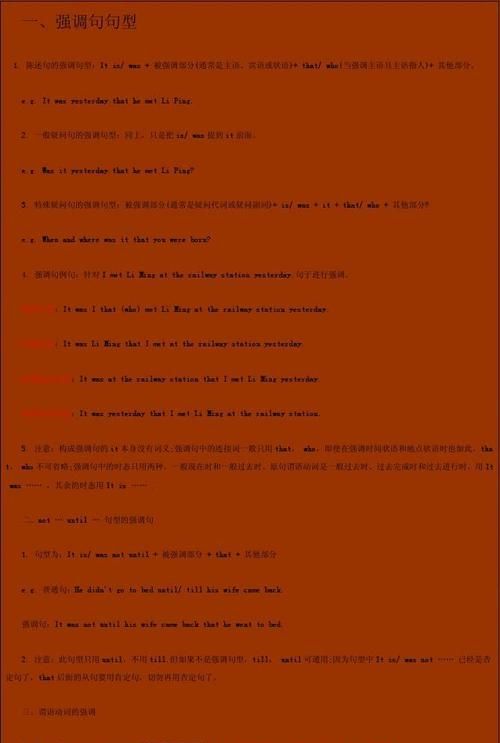
英语中强调句型的用法
1.一般情况用It is(was)……that…如: He read three books in the library yesterday. 我们分别可以强调主语、宾语、地点状语和时间状语。如: It was he who(that)read three books in the library yesterday.(强调主语) It was three books that he read in the library yesterday.(强调宾语) It was in the library that he read three books yesterday.(强调时间状语) 2.当被强调部分指人时,可用that,也可用who;指物时,只用what,如: It was Tom who(that)I met last week. It is a new boke that his brother wants to buy. 3.强调状语时,只用that,不用when、where.如: It is at 5 o'clock that the train will arrive. 4.被强调的部分是主语时,注意句子的谓语动词和被强调的主语保持一致。如: It is he who is late. It is they that were late. 5.一般疑问句的强调句为“Is (was) it that…?”;特殊疑问句为:“特殊疑问词 is (was) that…?”结构。如: Was it ten years ago that his father died?(他的父亲是十年前去世的吗?) When is it that you will set off?(你到底什么时候出发?) 6.“not…until…”句型的强调结构为“It is not until…that…”应注意把否定词not转移到until前面。如:I didn't go home until rain stopped.(直到雨停了我才回家)。 强调句为:It was not until rain stopped that I went home. I didn't know the news until yesterday.(直到昨天我才知道那个消息) 强调句为:It was not until yesterday that I knew the news.
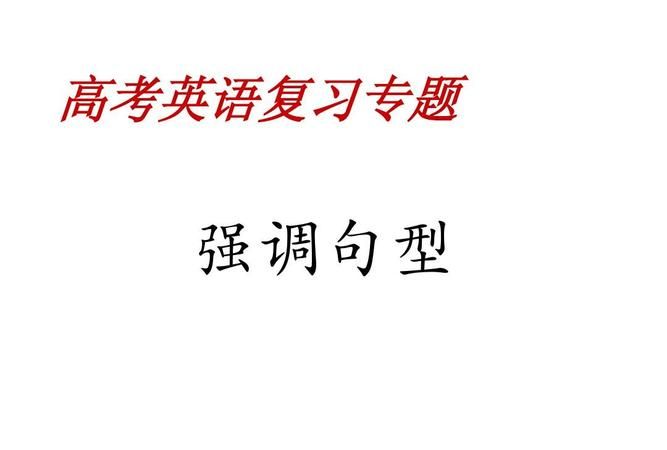
以上就是关于强调句型英语六个高中 ,英语强调句型结构及用法的全部内容,以及强调句型英语六个高中 的相关内容,希望能够帮到您。

